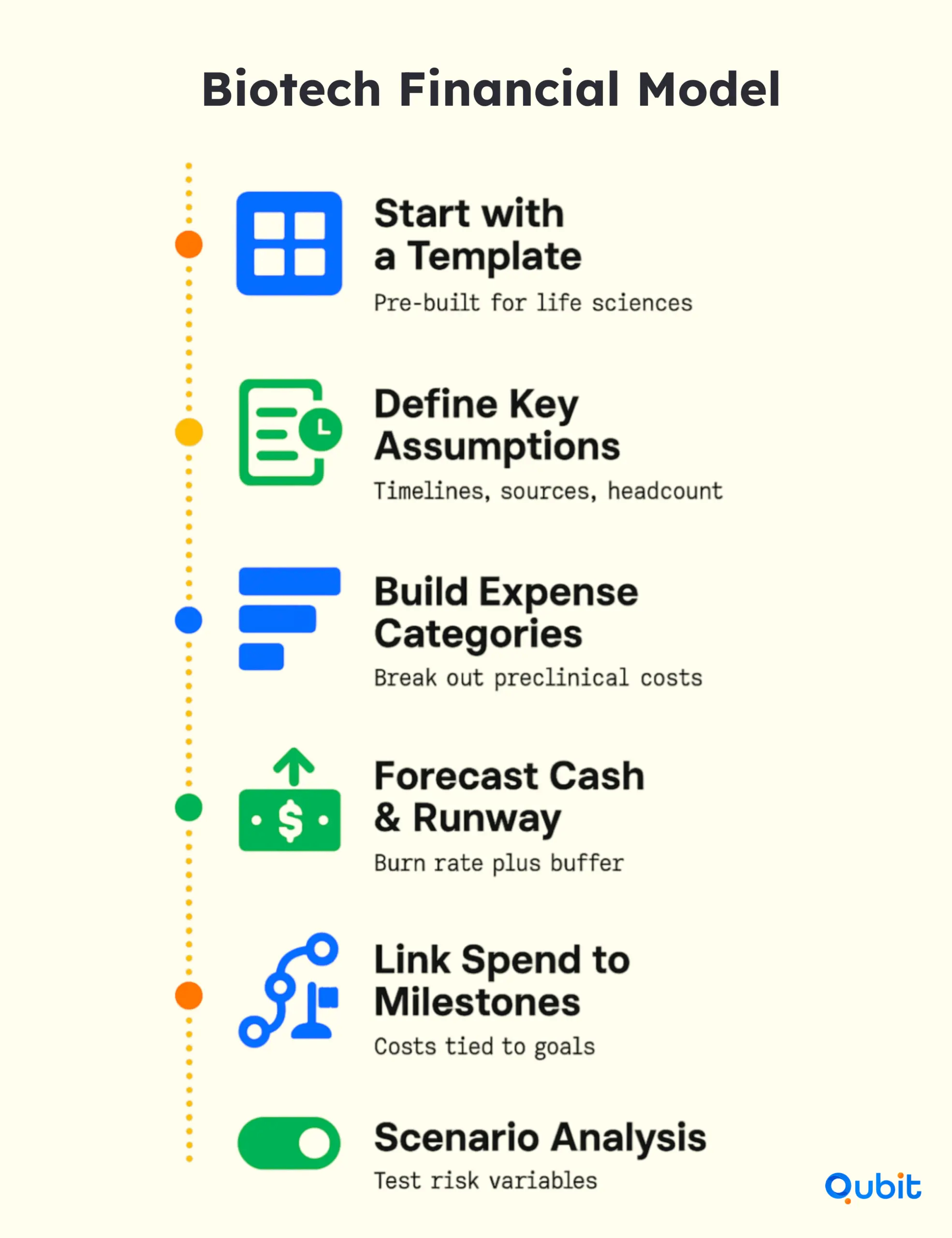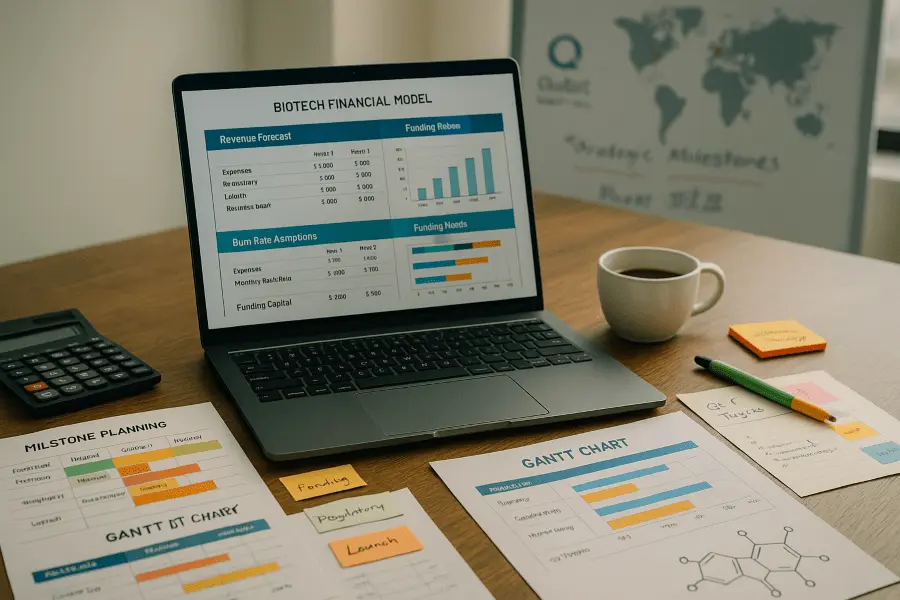Biotech startups face unique challenges when raising seed funding. Investors want to see a clear path from capital raised to value creation. Financial modeling and milestone planning are critical tools for founders to communicate this journey, set realistic expectations, and secure investor confidence.
For a broader strategic overview, check out our guide on biotech startup fundraising strategies, which complements the detailed modeling focus discussed here.
This article breaks down the essentials of financial modeling and milestone planning for biotech seed rounds, with practical steps, industry benchmarks, and actionable advice.
Why Financial Modeling Matters in Biotech
Financial modeling is more than just numbers on a spreadsheet. For biotech founders, it is a roadmap that shows how capital will be used to achieve scientific and business goals. A robust model demonstrates a founder’s understanding of costs, timelines, and risks. It also provides investors with a transparent view of the company’s potential return on investment.
Biotech ventures are capital intensive, with long timelines and high uncertainty. Unlike SaaS or consumer startups, revenue may be years away. Investors need to know that every dollar will be used efficiently to reach key inflection points. A strong financial model gives founders leverage in negotiations and helps prevent future funding gaps
Key Components of a Biotech Financial Model
1. Research and Development (R&D) Expenses
R&D is the biggest cost driver for early-stage biotech. Your model should break down expenses by project, phase, and activity. Include costs for lab supplies, personnel, preclinical studies, and external services. Use historical data, vendor quotes, and expert input to create realistic estimates.
2. Clinical Trial Costs
If your seed round will fund preclinical or clinical work, detail these costs separately. Include trial design, regulatory submissions, CRO fees, patient recruitment, and data analysis. Clinical trials are unpredictable, so include contingency buffers and scenario analysis.
3. Regulatory Timelines and Costs
Map out the regulatory pathway for your lead asset. Include costs for IND filing, regulatory consulting, and compliance. Investors want to see that you understand the regulatory landscape and have budgeted accordingly.
4. Operating Expenses
Capture all overheads, including salaries, rent, insurance, and legal fees. Early-stage teams are lean, but do not underestimate the cost of compliance, IP protection, and business development.
5. Revenue Forecasts (if applicable)
Most seed-stage biotechs are pre-revenue, but if you have potential for early income (e.g., grants, partnerships, or licensing), include conservative forecasts. Clearly separate non-dilutive funding from equity investment.
6. Cash Flow Projections
Project monthly cash burn and runway. Show how the seed round will sustain operations until the next value inflection point. Include sensitivity analysis for best and worst-case scenarios.
7. Milestone Mapping
Tie your financial model directly to scientific and business milestones. Each major spend should be linked to a clear deliverable, such as a patent filing, animal study completion, or IND submission.
For a deeper dive into preparing your biotech startup for investment, explore how to prepare biotech startup for investment. This resource offers actionable strategies to integrate operational readiness with funding plans.
How to Build a Biotech Seed Financial Model

Step 1: Start with a Template
Use industry-specific templates designed for life sciences. These models include sections for R&D, clinical, regulatory, and scenario analysis. Templates save time and ensure you do not miss critical components.
Step 2: Define Your Key Assumptions
List all major assumptions—timelines, headcount, trial size, and regulatory steps. Document sources for each assumption, such as published studies, expert interviews, or vendor quotes. This transparency builds investor trust.
Step 3: Build Out Expense Categories
Populate your model with detailed expense lines. For example, break down preclinical costs into animal studies, toxicology, and formulation. Use quotes and benchmarks to validate your numbers.
Step 4: Forecast Cash Flow and Runway
Calculate your monthly burn rate and runway. Show how the seed round will get you to the next major milestone. Include a buffer for unexpected delays or overruns.
Step 5: Link Milestones to Funding Needs
For each major milestone, estimate the required spend and expected timeline. For example, if your goal is to complete IND-enabling studies, show the cost and duration for each step. This linkage makes your ask more compelling to investors.
Step 6: Scenario and Sensitivity Analysis
Test your model under different scenarios—faster or slower enrollment, higher or lower costs, regulatory delays. Scenario analysis shows investors you are prepared for uncertainty and have a plan for managing risk.
Milestone Planning: What Investors Want to See
Investors fund milestones, not just ideas. Your plan should show how seed capital will deliver tangible progress and increase company value. Common biotech seed milestones include:
- Lead candidate selection and validation
- Completion of key preclinical studies (efficacy, safety, PK/PD)
- Patent filing or IP strengthening
- IND-enabling studies and regulatory submissions
- Securing a strategic partnership or grant
For each milestone, provide a timeline, budget, and success criteria. For example, “Complete GLP toxicology in 12 months for $800,000, with a go/no-go decision based on safety data.” This level of detail reassures investors and sets clear expectations for future rounds.
Industry Benchmarks for Biotech Seed Rounds
- Seed round sizes: In 2025, typical biotech seed rounds range from $2 million to $5 million, depending on asset stage and geography.
- Monthly burn rate: Early-stage biotechs often burn $100,000 to $250,000 per month, with lean teams and outsourced R&D.
- Runway: Investors expect at least 18 to 24 months of runway from a seed round, enough to reach the next value inflection point.
- Milestone-linked funding: Over 80% of funded biotech seed rounds in 2024-2025 were structured around clear, achievable milestones.
- Contingency: Models should include a 10-20% contingency buffer for unexpected costs or delays.
Practical Tips for Founders
- Document your assumptions: Keep a separate tab or document listing all key assumptions and their sources. This builds credibility and streamlines due diligence.
- Regularly update your model: Financial models are living documents. Update them as new data comes in or as milestones are achieved.
- Align with milestones: Make sure your funding ask matches the cost and timing of your next major milestone. Avoid raising too much or too little.
- Prepare for questions: Investors will challenge your assumptions. Be ready to defend your numbers with data, benchmarks, and expert input.
- Scenario plan: Show how you will adapt if timelines slip or costs rise. This demonstrates maturity and risk awareness.
- Visualize your plan: Use charts and timelines to make your model easy to understand. Visuals help investors quickly grasp your strategy and progress
Example: Linking Financial Model to Milestones
Suppose your biotech is developing a novel oncology therapy. Your seed round goal is to complete lead optimization and IND-enabling studies. Your model might show:
- $1.5 million for medicinal chemistry and lead selection (6 months)
- $800,000 for preclinical efficacy and safety studies (8 months)
- $400,000 for regulatory consulting and IND preparation (4 months)
- $300,000 for operating expenses and contingency
Each spend is tied to a deliverable (e.g., candidate selected, GLP tox completed, IND ready for submission). The model projects a 20-month runway, with a 15% contingency for unexpected costs. Scenario analysis tests what happens if studies take longer or cost more, helping you plan for the unexpected
Conclusion
Financial modeling and milestone planning are not just investor requirements—they are essential for founder success. A clear, data-driven model helps you anticipate challenges, allocate resources, and communicate your vision with confidence. By tying funding to achievable milestones, you increase your credibility and maximize your chances of raising capital.
Start with robust templates, document your assumptions, and update your plan as you learn. Align every dollar with a milestone that moves your company forward. This disciplined approach will set you apart in a competitive biotech market and lay the foundation for long-term growth
If you're ready to refine your financial projections and secure funding, we at Qubit Capital can help. Our Fundraising Assistance service is designed to support early-stage biotech startups in achieving their goals. Let us guide you through the process and help turn your vision into reality.
Key Takeaways
- Biotech seed financial models must detail R&D, trial costs, payroll, and capital needs to ensure investor clarity and strategic planning.
- Investors apply high discount rates due to long development timelines, making milestone-driven funding and de-risking strategies essential for early-stage biotech.
- Scenario analysis and robust assumptions are critical, as small changes in clinical or market factors can drastically impact biotech valuations.
- Linking funding requests directly to clear, achievable milestones increases credibility and aligns founder and investor expectations.
- Preparation, documentation, and a strong team are as vital as the science for successful seed fundraising in biotech
Frequently asked Questions
What are the key components of a financial model for biotech startups?
A biotech financial model must include detailed revenue projections tied to clinical and regulatory milestones, cost breakdowns for R&D and trials, and milestone‐based funding plans aligning scientific progress with capital needs.


 Back
Back



